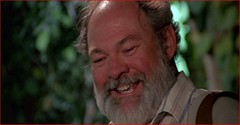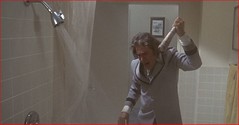Lisa and the Devil takes place almost exclusively in a house in Spain -- the location and time are never quite sure, nor are we certain these properties even exist within the mansion. Except for one, all the characters inside the mansion gradually come to terms with the fact that they will never leave, and gradually become just another of the house's faded memories. As a viewer, I began to feel the same enchanted qualities as the characters on screen, with little idea about my surroundings and certain that almost anything could lurk behind the next door. Lisa and the Devil is one of those rare movies (like Playtime, Nashville or even Rio Bravo) where you stop watching it to follow the story and start to soak up the atmosphere and characters as if you were one of them.
Lisa and the Devil is Mario Bava's most magical movie, but it also carries one of the cruelest of legacies. The director was given carte blanche privileges and a matching budget by producer Alfredo Leone (the duo's second collaboration, after Baron Blood), for the first time in his career he was able to make a film limited only by his imagination. With these expansive resources, Bava was able to assemble a quality cast and create a horror film without the shocking exploits or contrived plots of his previous efforts. While those films were brought to unforeseen heights by Bava's creative style, Lisa and the Devil would be his from the beginning -- and his high-art visuals would be matched with a story of subtle, morbid mystery. But this resulted in a commercially inviable product, which was shelved and later re-cut with new material and released as The House of Exorcism, a movie designed to cash in on The Exorcism's wake of popularity. It was a cruel fate for a movie that obviously took great pains to create -- especially since Bava himself had to film new scenes of a potty-mouthed possessed Elke Sommer that transformed the movie into a baffling genre exercise.
At dinner Lisa meets the odd occupants of the house: the dapper Max (Alessio Orano) and his unnamed mother, the Countess (Alida Vali, of The Third Man fame). The two are surprised to see Lisa at the table, and silently speak of her presence. After the tension-filled dinner things start going terribly wrong for everyone at the house: strange and brutal murders, appearances by ghostly visitors and a slow descent into the house's labyrinth of sin and madness. Lisa is also haunted by the fact that she is destined to remain in the mansion, possibly as a result of a previous life's event.
More than the story, it's the imagery of Lisa and the Devil that make it one of Bava's best movies. Every room in the mansion is filled with color, but they all have the shades of a wilting vase of flowers. This sense of rotting life is played creatively, none better than Leandro picking up a stale cupcake in his room and biting into its frosting with no emotion. The geography of the house seems to gradually melt, with no end to its corridors or decaying landscape in sight, and a late scene where Lisa tries to escape looks as if she has stepped into a painting. This adds to movie's increasing theme of isolation, as all views outside the mansion seem to fade away into darkness with no horizon in sight. Lisa and the Devil is my favorite of the eight movies in The Bava Box 2, and I've watched it more than any others in the set. It's hard (impossible?) to pin down, and that only adds to the experience.
Saturday, March 29, 2008
THE BAVA BEAT: 'Lisa and the Devil'
Filed Under The Bava Beat
Subscribe to:
Post Comments (Atom)














1 comment:
I could've sworn I posted a response earlier. Ah well. I love this movie more than is reasonable. An excellent, excellent film and a credit to Bava's genius.
I love your look at the movie's relation to space and geography -- or its general lack of one.
Post a Comment